苏州大学医学部药学院:大类基础课程《无机化学 Inorganic Chemistry》课程教学资源(电子教案)
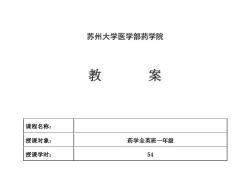
苏州大学医学部药学院 教 案 课程名称: 授课对象: 药学全英班一年级 授课学时: 54
苏州大学医学部药学院 教 案 课程名称: 授课对象: 药学全英班一年级 授课学时: 54
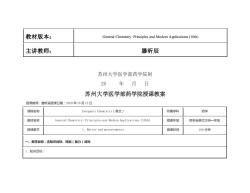
教材版本: General Chemistry:Principles and Modern Applications(10th) 主讲教师: 滕昕辰 苏州大学医学部药学院制 20 年月日 苏州大学医学部药学院授课教案 授课教师:滕昕辰授课日期:2020年10月12日 课程名称 Inorganic Chemistry(英文) 所属学科 药学 教材名称 General Chemistry:Principles and Modern Applications (10th) 授课年级 药学全英文方向一年级 授课章节 1.Matter and measurements 授课时间 100分钟 一、教学目标:含知识目标、技能(能力)目标 1.知识目标:
教材版本: General Chemistry: Principles and Modern Applications (10th) 主讲教师: 滕昕辰 苏州大学医学部药学院制 20 年 月 日 苏州大学医学部药学院授课教案 授课教师:滕昕辰授课日期:2020 年 10 月 12 日 课程名称 Inorganic Chemistry(英文) 所属学科 药学 教材名称 General Chemistry: Principles and Modern Applications (10th) 授课年级 药学全英文方向一年级 授课章节 1. Matter and measurements 授课时间 100 分钟 一、教学目标:含知识目标、技能(能力)目标 1.知识目标:
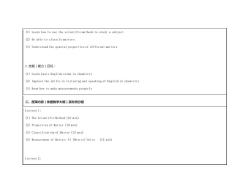
(1)Learn how to use the scientific methods to study a subject (2)Be able to classify matters (3)Understand the general properties of different matters 2.技能(能力)目标: (1)Learn basic English terms in chemistry (2)Improve the skills in listening and speaking of English in chemistry (3)Know how to make measurements properly 二、授课内容(依据教学大纲)及时间分配 Lecture 1: (1)The Scientific Method (10 min) (2)Properties of Matter (10 min) (3)Classification of Matter (15 min) (4)Measurement of Matter:SI (Metric)Units (15 min) Lecture 2:
(1) Learn how to use the scientific methods to study a subject (2) Be able to classify matters (3) Understand the general properties of different matters 2.技能(能力)目标: (1) Learn basic English terms in chemistry (2) Improve the skills in listening and speaking of English in chemistry (3) Know how to make measurements properly 二、授课内容(依据教学大纲)及时间分配 Lecture 1: (1) The Scientific Method (10 min) (2) Properties of Matter (10 min) (3) Classification of Matter (15 min) (4) Measurement of Matter: SI (Metric) Units (15 min) Lecture 2:
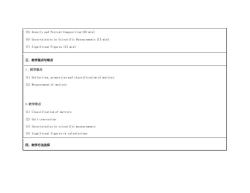
(5)Density and Percent Composition(20 min) (6)Uncertainties in Scientific Measurements(15 min) (7)Significant Figures (15 min) 三、教学重点与难点 1.教学重点 (1)Definition,properties and classification of matters (2)Measurement of matters 2.教学难点 (1)Classification of matters (2)Unit conversion (3)Uncertainties in scientific measurements (4)Significant figures in calculations 四、教学方法选择
(5) Density and Percent Composition (20 min) (6) Uncertainties in Scientific Measurements (15 min) (7) Significant Figures (15 min) 三、教学重点与难点 1.教学重点 (1) Definition, properties and classification of matters (2) Measurement of matters 2.教学难点 (1) Classification of matters (2) Unit conversion (3) Uncertainties in scientific measurements (4) Significant figures in calculations 四、教学方法选择
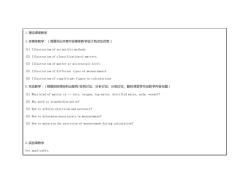
1.理论课堂教学 A.多媒体教学:(简要列出本章节多媒体教学设计特点及优势) (1)Illustration of scientific methods (2)Illustration of classification of matters (3)Illustration of matter at microscopic level (4)Illustration of different types of measurements (5)Illustration of significant figure in calculations B.互动教学:(根据实际情况列出案例/实例时论、分析讨论、分组讨论、翻转课堂等互动教学内容标题) (1)What kind of matter is .(air,oxygen,tap water,distilled water,soda,woods)? (2)Why need to standardize units? (3)How to achieve precision and accuracy? (4)How to determine uncertainty in measurement? (5)How to maintain the precision of measurement during calculation? 2.实验课教学 Not applicable
1.理论课堂教学 A.多媒体教学:(简要列出本章节多媒体教学设计特点及优势) (1) Illustration of scientific methods (2) Illustration of classification of matters (3) Illustration of matter at microscopic level (4) Illustration of different types of measurements (5) Illustration of significant figure in calculations B.互动教学:(根据实际情况列出案例/实例讨论、分析讨论、分组讨论、翻转课堂等互动教学内容标题) (1) What kind of matter is … (air, oxygen, tap water, distilled water, soda, woods)? (2) Why need to standardize units? (3) How to achieve precision and accuracy? (4) How to determine uncertainty in measurement? (5) How to maintain the precision of measurement during calculation? 2.实验课教学 Not applicable
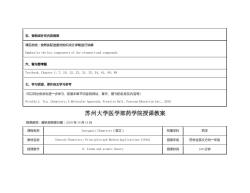
五、更新或补充内容提要 课后总结:按照实际进度对知识点分详略进行讲解 Emphasize the key components of the elements and compounds 六、复习思考题 Textbook,Chapter1:7,10,12,23,31,32,54,61,69,89 七、学习资源、课外自主学习参考 (可以列出供学生进一步学习、拓展本章节内容的网站、著作、期刊的名称及内容等) Nivaldo J.Tro,Chemistry:A Molecular Approach,Prentice Hall,Pearson Education Inc.,2010 苏州大学医学部药学院授课教案 授课教师:滕昕辰授课日期:2020年10月15日 课程名称 Inorganic Chemistry(英文) 所属学科 药学 教材名称 General Chemistry:Principles and Modern Applications (10th) 授课年级 药学全英文方向一年级 授课章节 2.Atoms and atomic theory 授课时间 100分钟
五、更新或补充内容提要 课后总结:按照实际进度对知识点分详略进行讲解 Emphasize the key components of the elements and compounds 六、复习思考题 Textbook, Chapter 1: 7, 10, 12, 23, 31, 32, 54, 61, 69, 89 七、学习资源、课外自主学习参考 (可以列出供学生进一步学习、拓展本章节内容的网站、著作、期刊的名称及内容等) Nivaldo J. Tro, Chemistry: A Molecular Approach, Prentice Hall, Pearson Education Inc., 2010 苏州大学医学部药学院授课教案 授课教师:滕昕辰授课日期:2020 年 10 月 15 日 课程名称 Inorganic Chemistry(英文) 所属学科 药学 教材名称 General Chemistry: Principles and Modern Applications (10th) 授课年级 药学全英文方向一年级 授课章节 2. Atoms and atomic theory 授课时间 100 分钟
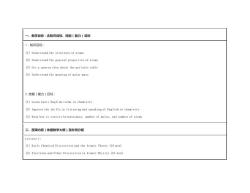
一、教学目标:含知识目标、技能(能力)目标 1.知识目标: (1)Understand the structure of atoms (2)Understand the general properties of atoms (3)Get a genera idea about the periodic table (4)Understand the meaning of molar mass 2.技能(能力)目标: (1)Learn basic English terms in chemistry (2)Improve the skills in listening and speaking of English in chemistry (3)Know how to convert between mass,number of moles,and number of atoms 二、授课内容(依据教学大纲)及时间分配 Lecture 1: (1)Early Chemical Discoveries and the Atomic Theory (10 min) (2)Electrons and Other Discoveries in Atomic Physics (10 min)
一、教学目标:含知识目标、技能(能力)目标 1.知识目标: (1) Understand the structure of atoms (2) Understand the general properties of atoms (3) Get a genera idea about the periodic table (4) Understand the meaning of molar mass 2.技能(能力)目标: (1) Learn basic English terms in chemistry (2) Improve the skills in listening and speaking of English in chemistry (3) Know how to convert between mass, number of moles, and number of atoms 二、授课内容(依据教学大纲)及时间分配 Lecture 1: (1) Early Chemical Discoveries and the Atomic Theory (10 min) (2) Electrons and Other Discoveries in Atomic Physics (10 min)
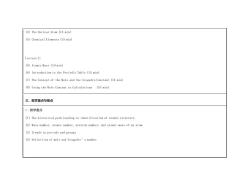
(3)The Nuclear Atom (15 min) (4)Chemical Elements (15 min) Lecture 2: (5)Atomic Mass (10 min) (6)Introduction to the Periodic Table (15 min) (7)The Concept of the Mole and the Avogadro Constant (15 min) (8)Using the Mole Concept in Calculations (10 min) 三、教学重点与难点 1.教学重点 (1)The historical path leading to identification of atomic structure (2)Mass number,atomic number,neutron number,and atomic mass of an atom (3)Trends in periods and groups (4)Definition of mole and Avogadro's number
(3) The Nuclear Atom (15 min) (4) Chemical Elements (15 min) Lecture 2: (5) Atomic Mass (10 min) (6) Introduction to the Periodic Table (15 min) (7) The Concept of the Mole and the Avogadro Constant (15 min) (8) Using the Mole Concept in Calculations (10 min) 三、教学重点与难点 1.教学重点 (1) The historical path leading to identification of atomic structure (2) Mass number, atomic number, neutron number, and atomic mass of an atom (3) Trends in periods and groups (4) Definition of mole and Avogadro’s number
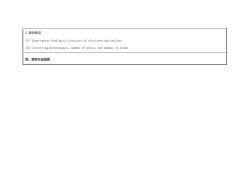
2.教学难点 (1)Experiments leading to discovery of electrons and nucleus (2)Converting between mass,number of moles,and number of atoms 四、教学方法选择
2.教学难点 (1) Experiments leading to discovery of electrons and nucleus (2) Converting between mass, number of moles, and number of atoms 四、教学方法选择
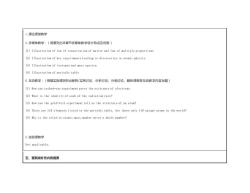
1.理论课堂教学 A.多媒体教学:(简要列出本章节多媒体教学设计特点及优势) (1)Illustration of law of conservation of matter and law of multiple proportions (2)Illustration of key experiments leading to discoveries in atomic physics (3)Illustration of isotopes and mass spectra (4)Illustration of periodic table B.互动教学:(根据实际情况列出案例/实例讨论、分析讨论、分组讨论、翻转课堂等互动教学内容标题) (1)How can cathod-ray experiment prove the existence of electrons (2)What is the identity of each of the radiation rays? (3)How can the gold-foil experiment tell us the structure of an atom? (4)There are 118 elements listed in the periodic table.Are there only 118 unique atoms in the world? (5)Why is the relative atomic mass number never a whole number? 2.实验课教学 Not applicable. 五、更新或补充内容提要
1.理论课堂教学 A.多媒体教学:(简要列出本章节多媒体教学设计特点及优势) (1) Illustration of law of conservation of matter and law of multiple proportions (2) Illustration of key experiments leading to discoveries in atomic physics (3) Illustration of isotopes and mass spectra (4) Illustration of periodic table B.互动教学:(根据实际情况列出案例/实例讨论、分析讨论、分组讨论、翻转课堂等互动教学内容标题) (1) How can cathod-ray experiment prove the existence of electrons (2) What is the identity of each of the radiation rays? (3) How can the gold-foil experiment tell us the structure of an atom? (4) There are 118 elements listed in the periodic table. Are there only 118 unique atoms in the world? (5) Why is the relative atomic mass number never a whole number? 2.实验课教学 Not applicable. 五、更新或补充内容提要
按次数下载不扣除下载券;
注册用户24小时内重复下载只扣除一次;
顺序:VIP每日次数-->可用次数-->下载券;
- 苏州大学医学部药学院:大类基础课程《无机化学 Inorganic Chemistry》课程教学资源(教学大纲).docx
- 苏州大学医学部药学院:大类基础课程《分析化学 Analytical Chemistry》课程教学资源(电子教案).docx
- 苏州大学医学部药学院:大类基础课程《分析化学 Analytical Chemistry》课程教学资源(教学大纲).docx
- 苏州大学医学部药学院:大类基础课程《有机化学 Organic Chemistry》课程教学资源(电子教案).docx
- 苏州大学医学部药学院:大类基础课程《有机化学 Organic Chemistry》课程教学资源(教学大纲).docx
- 苏州大学医学部药学院:大类基础课程《物理化学 Physical Chemistry》课程教学资源(电子教案).docx
- 苏州大学医学部药学院:大类基础课程《物理化学 Physical Chemistry》课程教学资源(教学大纲).docx
- 苏州大学医学部药学院:大类基础课程《细胞与分子生物学实验 Cellular and Molecular Biology Experiment》课程教学资源(电子教案).pdf
- 苏州大学医学部药学院:大类基础课程《细胞与分子生物学实验 Cellular and Molecular Biology Experiment》课程教学资源(教学大纲).docx
- 苏州大学医学部药学院:大类基础课程《微生物与免疫学实验 Microbiology & Immunology Experiments》课程教学资源(电子教案).docx
- 苏州大学医学部药学院:大类基础课程《微生物与免疫学实验 Microbiology & Immunology Experiments》课程教学资源(教学大纲).docx
- 苏州大学医学部药学院:专业必修课程《学科综合训练 Comprehensive Discipline Training》课程教学资源(教学大纲).docx
- 苏州大学医学部药学院:专业必修课程《药物合成 Drug Synthesis》课程教学资源(电子教案).docx
- 苏州大学医学部药学院:专业必修课程《药物合成 Drug Synthesis》课程教学资源(教学大纲).docx
- 苏州大学医学部药学院:专业必修课程《药剂学与药物动力学 Biopharmaceutics and Pharmacokinetics》课程教学资源(电子教案).docx
- 苏州大学医学部药学院:专业必修课程《药剂学与药物动力学 Biopharmaceutics and Pharmacokinetics》课程教学资源(教学大纲).docx
- 苏州大学医学部药学院:专业必修课程《生物药剂学与药物动力学实验 Biopharmaceutics and pharmacokinetic experiments》课程教学资源(教学大纲).docx
- 苏州大学医学部药学院:专业必修课程《天然药物化学 Natural Medicinal Chemistry》课程教学资源(教学大纲).docx
- 苏州大学医学部药学院:专业必修课程《药用植物学与生药学 Pharmaceutical Botany &Pharmacognosy》课程教学资源(电子教案).docx
- 苏州大学医学部药学院:专业必修课程《药用植物学与生药学 Pharmaceutical Botany &Pharmacognosy》课程教学资源(教学大纲).docx
- 苏州大学医学部药学院:大类基础课程《免疫学及微生物学 Microbiology & Immunology》课程教学资源(教学大纲).pdf
- 苏州大学医学部药学院:大类基础课程《免疫学及微生物学 Microbiology & Immunology》课程教学资源(电子教案).docx
- 苏州大学医学部药学院:大类基础课程《分子细胞生物学 Molecular cell Biology》课程教学资源(教学大纲).docx
- 苏州大学医学部药学院:大类基础课程《分子细胞生物学 Molecular cell Biology》课程教学资源(授课教案).pdf
- 苏州大学医学部药学院:大类基础课程《生物化学 Biochemistry V》课程教学资源(教学大纲).pdf
- 苏州大学医学部药学院:大类基础课程《生物化学 Biochemistry V》课程教学资源(电子教案).pdf
- 苏州大学医学部药学院:大类基础课程《生物化学实验 Biochemistry V Experiment》课程教学资源(电子教案).pdf
- 苏州大学医学部药学院:大类基础课程《生物化学实验 Biochemistry V Experiment》课程教学资源(教学大纲).pdf
- 苏州大学医学部药学院:大类基础课程《解剖生理学 Anatomical Physiology》课程教学资源(电子教案).pdf
- 苏州大学医学部药学院:大类基础课程《解剖生理学 Anatomical Physiology(人体解剖学 Human Anatomy part)》课程教学资源(教学大纲).docx
- 苏州大学医学部药学院:大类基础课程《解剖生理学实验 Anatomical Physiology Experiment》课程教学资源(教学大纲).docx
- 苏州大学医学部药学院:大类基础课程《解剖生理学实验 Anatomical Physiology Experiment》课程教学资源(电子教案).docx
- 苏州大学医学部药学院:大类基础课程《物理化学及实验 Physical chemistry and Experiments》课程教学资源(教学大纲).docx
- 山东大学:药剂学(PPT课件讲稿)Pharmaceutics.ppt
- 长沙医学院:《药剂学》课程教学资源(PPT课件讲稿)第八章 软膏剂与凝胶剂.ppt
- 长沙医学院:《药剂学》课程教学资源(PPT课件讲稿)第七章 注射剂和滴眼剂(7.5-7.7).ppt
- 长沙医学院:《药剂学》课程教学资源(PPT课件讲稿)第三章 散剂、颗粒剂与胶囊剂 第一节 粉体学简介(Micromeritics).ppt
- 长沙医学院:《药剂学》课程教学资源(PPT课件讲稿)第十五章 药物制剂的稳定性.ppt
- 长沙医学院:《药剂学》课程教学资源(PPT课件讲稿)第十章 中药药剂学——散剂.ppt
- 长沙医学院:《药剂学》课程教学资源(PPT课件讲稿)第四章 片剂(主讲:唐靖).ppt
